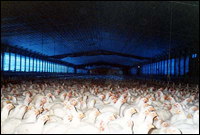On Friday, in the shadow of the splashy presidential inauguration jamboree, the Bush EPA offered factory farms a tempting tradeoff: more than two years of immunity from the Clean Air Act and certain toxic-discharge standards in exchange for participating in a data-collection program that would monitor air emissions from their facilities.

Factory farms may be getting off easy, but not so the chickens.
Photo: Farm Sanctuary.
EPA enforcement honcho Thomas Skinner hailed the agreement in a statement as “a huge step forward” in the effort to reduce factory-farm emissions, while environmentalists say the deal stinks as bad as the mountains of steaming excrement responsible for the harmful pollutants these farms emit.
Over the past decade, as the meat, dairy, and egg industries have boomed and been consolidated, massive factories — known as concentrated animal feeding operations, or CAFOs — have replaced many smaller-scale farms. The huge numbers of chickens, hogs, and heifers in these densely packed facilities produce even huger piles of waste, which in turn produce ammonia, hydrogen sulfide, volatile organic compounds, and particulates. Exactly how much of these pollutants, we don’t yet know; CAFOs’ emissions haven’t been systematically studied.
Bush officials say they need to gather emissions data before they can “make informed regulatory and policy determinations” about how to curb CAFO pollution, and they say their new plan is just the way to do it. In exchange for amnesty for air violations during the next two years, as well as any previous infractions, CAFOs participating in the voluntary program will fund emissions monitoring.
“The Clean Air Act as designed didn’t have huge feeding operations in mind; [CAFOs are] different from most of the things it regulates,” EPA press secretary Cynthia Bergman told Muckraker. Data gathered via the new system will yield “a representative sampling from which we can estimate the emissions from all kinds of farms around the country,” she said. “This way we can get far more [CAFOs] into compliance than by the traditional case-by-case approach.” The agency touts the collaborative nature of its plan, saying that a strategy of slapping lawsuits one by one on CAFOs that violate Clean Air Act standards would be too costly and time-consuming. Bergman stresses that the deal requires all participating facilities to come into compliance with the law once the monitoring project is complete.
Enviros counter that while new data would be warmly welcomed, there’s no need to paralyze the law-enforcement process in order to collect it. “It’s true that much of the consolidation has happened in the last decade, so everybody agrees that additional data collection is appropriate,” said Michele Merkel, a former staff attorney in the EPA’s enforcement division who filed the agency’s first suit against a CAFO for Clean Air Act violations in October 1999, under the Clinton administration. “But the Clean Air Act on its own requires polluting facilities to provide this kind of data. EPA does not need to suspend its enforcement authority while the monitoring takes place.”
Merkel, now an attorney with the Environmental Integrity Project, says that a halt to enforcement could mean increased health risks for CAFO employees and nearby residents from toxic emissions such as ammonia and hydrogen sulfide released by decomposing feces. A 2002 study by Iowa State University and the University of Iowa Study Group revealed widespread cases of bronchitis in workers exposed to these pollutants.
According to Ed Hopkins, environmental quality director for the Sierra Club, the biggest CAFOs have emission levels comparable to those of industrial manufacturing facilities. One egg farm in Iowa was recently found to have ammonia emissions on par with a fertilizer manufacturing plant ranked as the ninth biggest producer of this hazardous gas in the country, he said.

Hold your nose.
Photo: Farm Sanctuary.
Environmentalists also note that the fees required to participate in the program are a pittance compared to penalties that can be levied under the Clean Air Act. In addition to the $2,500 membership fee, CAFO-owning companies will be asked to cough up a one-time penalty of between $200 and $100,000 (according to the number and size of their facilities) to be pardoned for “presumed” past air-quality violations. “This is chump change compared to the fines violators have faced in the past,” said Merkel. Under the Clean Air Act, farms violating the law can be fined up to $27,500 per day per facility.
The only sliver of hope, enviros say, is that the plan is subject to a 30-day public-comment period — a protocol that was left out of the initial draft of the agreement. “We got a tip from someone inside the agency that they were going to cut the public-comment period altogether, knowing that [the amnesty plan] would provoke an outcry,” said Merkel. “A number of us, including Capitol Hill staffers, weighed in and made sure it was reinstated.”
It’s no coincidence that the deal made its public debut the day after the president was sworn in for his second term, Merkel claims. “Politically it was much easier for them to get it out now than at the end of the first term. They were getting a lot of public pressure when word of this deal got out months ago, so they knew it would turn heads.”
The day after the inauguration was also a good time to return favors from factory-farm giants such as Tyson Foods, which lobbied heavily in favor of the voluntary program. It just so happens that Tyson was among the biggest contributors to the inaugural festivities, having forked over a cool $100,000 for the affair. Among the goodies Tyson execs received for their donation were VIP tickets to the inaugural parade and a candlelight dinner for 10 with Dubya and the Veep. But, enviros argue, even those party favors don’t hold a candle to the get-out-of-jail-free card they got handed on the full first day of Bush’s second term.

